初中英语教学设计方案
初中英语优秀教学设计模板(精选6篇)
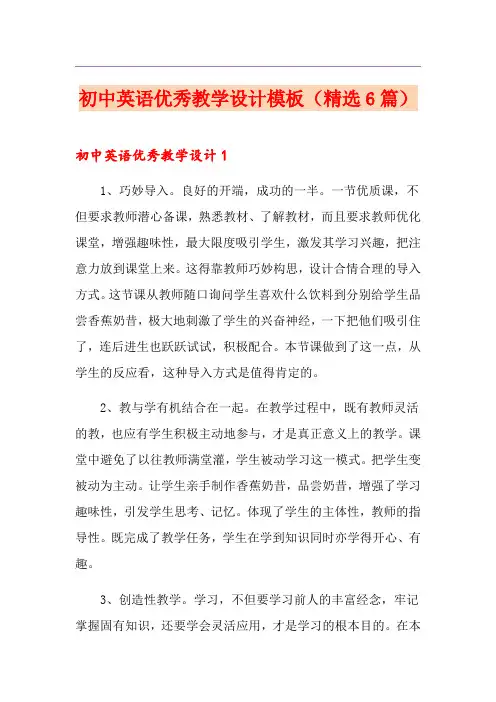
初中英语优秀教学设计模板(精选6篇)初中英语优秀教学设计11、巧妙导入。
良好的开端,成功的一半。
一节优质课,不但要求教师潜心备课,熟悉教材、了解教材,而且要求教师优化课堂,增强趣味性,最大限度吸引学生,激发其学习兴趣,把注意力放到课堂上来。
这得靠教师巧妙构思,设计合情合理的导入方式。
这节课从教师随口询问学生喜欢什么饮料到分别给学生品尝香蕉奶昔,极大地刺激了学生的兴奋神经,一下把他们吸引住了,连后进生也跃跃试试,积极配合。
本节课做到了这一点,从学生的反应看,这种导入方式是值得肯定的。
2、教与学有机结合在一起。
在教学过程中,既有教师灵活的教,也应有学生积极主动地参与,才是真正意义上的教学。
课堂中避免了以往教师满堂灌,学生被动学习这一模式。
把学生变被动为主动。
让学生亲手制作香蕉奶昔,品尝奶昔,增强了学习趣味性,引发学生思考、记忆。
体现了学生的主体性,教师的指导性。
既完成了教学任务,学生在学到知识同时亦学得开心、有趣。
3、创造性教学。
学习,不但要学习前人的丰富经念,牢记掌握固有知识,还要学会灵活应用,才是学习的根本目的。
在本课堂,大胆进行教学拓展。
在学生学会制作、描述制作奶昔之后。
设计让学生充分使用发散思维,想象制作其他奶昔或食品的方法。
通过学生们的积极努力,不但学会了制作香蕉奶昔,也探讨到了制作其他食品的方法。
达到触类旁通的效果4、学习过程同时也是发现归纳的过程。
学生是学习的主体,不但要跟随教师学习,也应在学习过程中善于归纳总结,自己得出结论。
所学的知识才印象深刻,牢固掌握。
把别人的知识经验变成自己的知识经验。
我在处理how much与how many的区别用法时疏忽了这点,没有让学生自己发现总结出来,而是直接告诉他们,然后通过几个简单练习来巩固。
使得学生记忆机械,呆板。
效果也欠佳。
5、掌控课堂,灵活教学。
灵活过渡,必要时采取有效的取舍,游刃有余是每位优秀教师应该具备的素质。
我在上课时完全按照备好的课按部就班,觉得每一步骤都很重要,不可少。
初中英语课堂教学设计案例优秀9篇
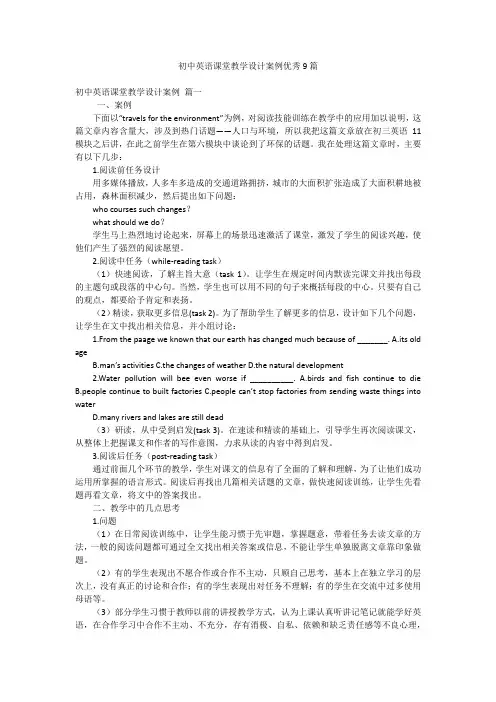
初中英语课堂教学设计案例优秀9篇初中英语课堂教学设计案例篇一一、案例下面以“travels for the environment”为例,对阅读技能训练在教学中的应用加以说明,这篇文章内容含量大,涉及到热门话题——人口与环境,所以我把这篇文章放在初三英语11模块之后讲,在此之前学生在第六模块中谈论到了环保的话题。
我在处理这篇文章时,主要有以下几步:1.阅读前任务设计用多媒体播放,人多车多造成的交通道路拥挤,城市的大面积扩张造成了大面积耕地被占用,森林面积减少,然后提出如下问题:who courses such changes?what should we do?学生马上热烈地讨论起来,屏幕上的场景迅速激活了课堂,激发了学生的阅读兴趣,使他们产生了强烈的阅读愿望。
2.阅读中任务(while-reading task)(1)快速阅读,了解主旨大意(task 1)。
让学生在规定时间内默读完课文并找出每段的主题句或段落的中心句。
当然,学生也可以用不同的句子来概括每段的中心。
只要有自己的观点,都要给予肯定和表扬。
(2)精读,获取更多信息(task 2)。
为了帮助学生了解更多的信息,设计如下几个问题,让学生在文中找出相关信息,并小组讨论:1.From the paage we known that our earth has changed much because of _______. A.its old ageB.man’s activitiesC.the changes of weatherD.the natural development2.Water pollution will bee even worse if __________. A.birds and fish continue to dieB.people continue to built factoriesC.people can’t stop factories from sending waste things into waterD.many rivers and lakes are still dead(3)研读,从中受到启发(task 3)。
初中英语教案完整版
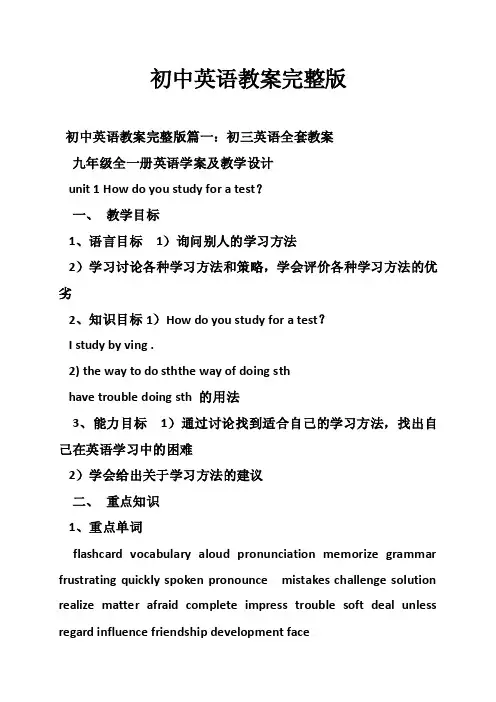
初中英语教案完整版初中英语教案完整版篇一:初三英语全套教案九年级全一册英语学案及教学设计unit 1 How do you study for a test?一、教学目标1、语言目标1)询问别人的学习方法2)学习讨论各种学习方法和策略,学会评价各种学习方法的优劣2、知识目标1)How do you study for a test?I study by ving .2) the way to do sththe way of doing sthhave trouble doing sth 的用法3、能力目标1)通过讨论找到适合自己的学习方法,找出自己在英语学习中的困难2)学会给出关于学习方法的建议二、重点知识1、重点单词flashcard vocabulary aloud pronunciation memorize grammar frustrating quickly spoken pronounce mistakes challenge solution realize matter afraid complete impress trouble soft deal unless regard influence friendship development face基本要求:会读、会写、会用。
2、重点短语make mistakes be afraid to do sth laugh at enjoy doing sth the way to do sth have trouble doing sthend upspoken English practice doing sth too much look upmake vocabulary liststry one`s best to do sth基本要求:会读、会写、会用。
3、重点语法1)How 引起的特殊疑问句及其回答2)the way to do sth the way of doing sthhave trouble doing sth 的用法基本要求:理解其含义,学以致用。
优秀教学设计初中英语
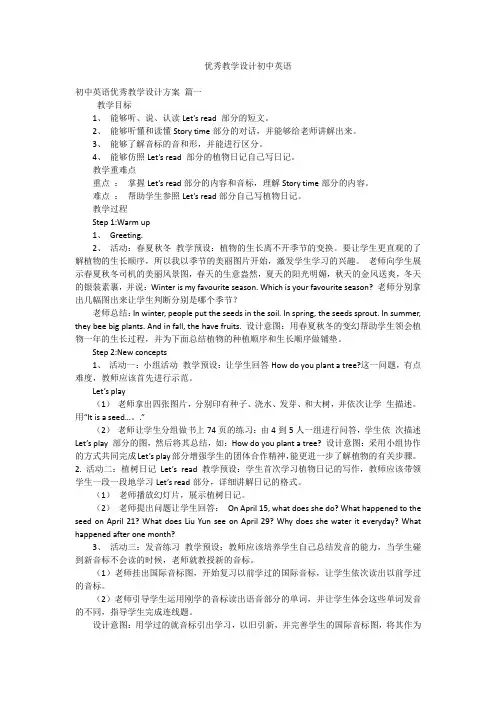
优秀教学设计初中英语初中英语优秀教学设计方案篇一教学目标1、能够听、说、认读Let’s read 部分的短文。
2、能够听懂和读懂Story time部分的对话,并能够给老师讲解出来。
3、能够了解音标的音和形,并能进行区分。
4、能够仿照Let’s read 部分的植物日记自己写日记。
教学重难点重点:掌握Let’s read部分的内容和音标,理解Story time部分的内容。
难点:帮助学生参照Let’s read部分自己写植物日记。
教学过程Step 1:Warm up1、Greeting.2、活动:春夏秋冬教学预设:植物的生长离不开季节的变换。
要让学生更直观的了解植物的生长顺序,所以我以季节的美丽图片开始,激发学生学习的兴趣。
老师向学生展示春夏秋冬司机的美丽风景图,春天的生意盎然,夏天的阳光明媚,秋天的金风送爽,冬天的银装素裹,并说:Winter is my favourite season. Which is your favourite season? 老师分别拿出几幅图出来让学生判断分别是哪个季节?老师总结:In winter, people put the seeds in the soil. In spring, the seeds sprout. In summer, they bee big plants. And in fall, the have fruits. 设计意图:用春夏秋冬的变幻帮助学生领会植物一年的生长过程,并为下面总结植物的种植顺序和生长顺序做铺垫。
Step 2:New concepts1、活动一:小组活动教学预设:让学生回答How do you plant a tree?这一问题,有点难度,教师应该首先进行示范。
Let’s play(1)老师拿出四张图片,分别印有种子、浇水、发芽、和大树,并依次让学生描述。
用“It is a seed…。
.”(2)老师让学生分组做书上74页的练习:由4到5人一组进行问答,学生依次描述Let’s play 部分的图,然后将其总结,如:How do you plant a tree? 设计意图:采用小组协作的方式共同完成Let’s play部分增强学生的团体合作精神,能更进一步了解植物的有关步骤。
初中仁爱英语优秀教学设计5篇
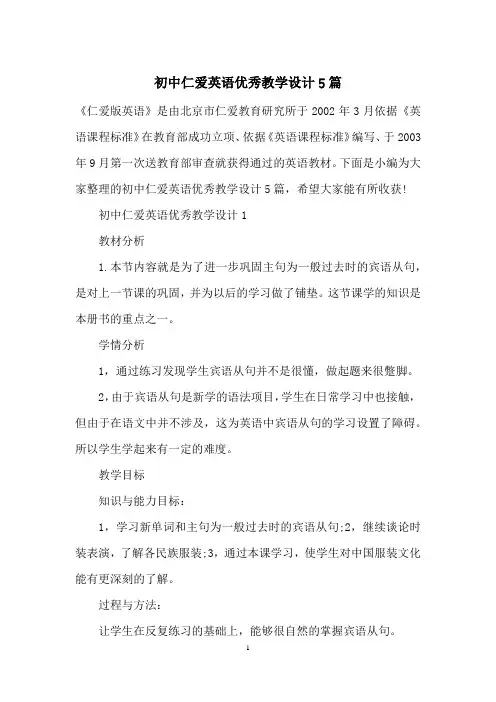
初中仁爱英语优秀教学设计5篇《仁爱版英语》是由北京市仁爱教育研究所于2002年3月依据《英语课程标准》在教育部成功立项、依据《英语课程标准》编写、于2003年9月第一次送教育部审查就获得通过的英语教材。
下面是小编为大家整理的初中仁爱英语优秀教学设计5篇,希望大家能有所收获!初中仁爱英语优秀教学设计1教材分析1.本节内容就是为了进一步巩固主句为一般过去时的宾语从句,是对上一节课的巩固,并为以后的学习做了铺垫。
这节课学的知识是本册书的重点之一。
学情分析1,通过练习发现学生宾语从句并不是很懂,做起题来很蹩脚。
2,由于宾语从句是新学的语法项目,学生在日常学习中也接触,但由于在语文中并不涉及,这为英语中宾语从句的学习设置了障碍。
所以学生学起来有一定的难度。
教学目标知识与能力目标:1,学习新单词和主句为一般过去时的宾语从句;2,继续谈论时装表演,了解各民族服装;3,通过本课学习,使学生对中国服装文化能有更深刻的了解。
过程与方法:让学生在反复练习的基础上,能够很自然的掌握宾语从句。
情感态度和价值观:通过対本课的学习,让学生了解民族服装文化,加强对民族服装文化的了解,增进民族感情。
教学重点和难点主句为一般过去时的宾语从句教学过程(本文来自优秀教育资源网斐.斐.课.件.园)Step 1. Review the object clauses of which the main clauses are in the pastsimple tense..Step 2. Lead in the new lesson and learn new words.Step 3.Presention:1.Listen to the tape and pay attention to the pronunciation. Read 1a indifferent ways to learn it2. Let the students answer some questi___. And then fill in blanksaccording to 1a.Step 4. PracticeLead into Part 2and practice the object clauses of which the main clausesare in the past simple tense.Step 5.C___olidation :Step 6.Homework:教学环节一,复习二,导入三,呈现四,练习五,巩固六,作业复习宾语从句,然后利用宾语从句引入新课,并展示图片,学习生词,进而学习少数民族服装,处理第三部分。
初中英语实践教学设计(3篇)
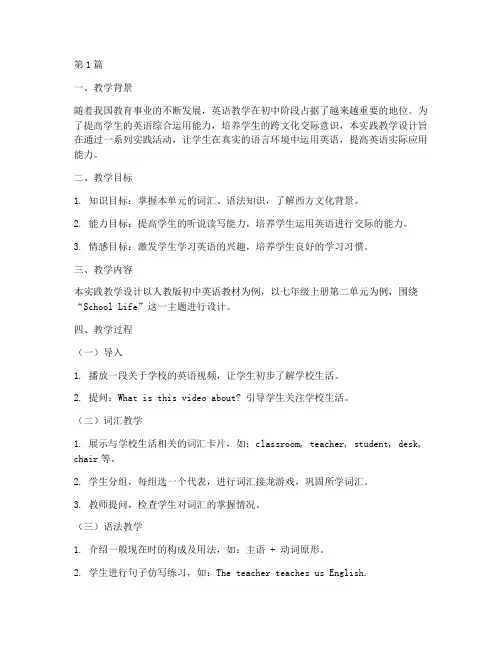
第1篇一、教学背景随着我国教育事业的不断发展,英语教学在初中阶段占据了越来越重要的地位。
为了提高学生的英语综合运用能力,培养学生的跨文化交际意识,本实践教学设计旨在通过一系列实践活动,让学生在真实的语言环境中运用英语,提高英语实际应用能力。
二、教学目标1. 知识目标:掌握本单元的词汇、语法知识,了解西方文化背景。
2. 能力目标:提高学生的听说读写能力,培养学生运用英语进行交际的能力。
3. 情感目标:激发学生学习英语的兴趣,培养学生良好的学习习惯。
三、教学内容本实践教学设计以人教版初中英语教材为例,以七年级上册第二单元为例,围绕“School Life”这一主题进行设计。
四、教学过程(一)导入1. 播放一段关于学校的英语视频,让学生初步了解学校生活。
2. 提问:What is this video about? 引导学生关注学校生活。
(二)词汇教学1. 展示与学校生活相关的词汇卡片,如:classroom, teacher, student, desk, chair等。
2. 学生分组,每组选一个代表,进行词汇接龙游戏,巩固所学词汇。
3. 教师提问,检查学生对词汇的掌握情况。
(三)语法教学1. 介绍一般现在时的构成及用法,如:主语 + 动词原形。
2. 学生进行句子仿写练习,如:The teacher teaches us English.3. 教师巡视指导,纠正错误。
(四)听力训练1. 播放一段关于学校生活的英语听力材料,让学生根据听力内容回答问题。
2. 教师总结听力技巧,如:关注关键词,注意语音语调等。
(五)阅读训练1. 分发课文,让学生自主阅读,了解文章大意。
2. 教师提问,检查学生对文章的理解。
3. 学生分组讨论,分享阅读心得。
(六)口语交际1. 教师设置情景,如:介绍自己的学校,询问同学的学校等。
2. 学生分组进行口语交际练习,教师巡视指导。
(七)总结与反思1. 教师总结本节课所学内容,强调重点和难点。
初中英语课教学设计(共8篇)(精简版)
初中英语课教学设计(共8篇)初中英语课教学设计(共8篇)篇一:初中英语课堂教学设计初中英语课堂教学设计课题:Unit 4 It as built over 2,000 years ago 设计人:黑龙江省泰来县孙放图片已关闭显示,点此查看图片已关闭显示,点此查看图片已关闭显示,点此查看图片已关闭显示,点此查看篇二:初中英语教案模板Teaching Plan Student: The students of Grade 9 Teaching Content: Go for it, students’ book of grade 9. Unit 1, the title is Ho do you study for a test? Section B, 3a, 3b,3c. Teaching hour: One class hour Teaching plan: I. Teaching Aims: 1. Learn and master ne ords, phrases and sentence patterns.2. Enable the students to talk in English about ho to study English very ell.3. Develop the students speaking and riting ability. II. Teaching Main Points: 1. Improve the students’ speaking and riting ability. 2. Master some phrases and some sentence patterns. III. Teaching Difficult Points: 1. Phrases: first of all, later on, laugh at, take notes 2. Sentence Patterns: Sb. be afraid to do sth. Sb. realize that –clause IV. Teaching Methods: 1. Fast reading to find out the general information about the passage.2. Question-and-anseractivities to help the students to go through the hole passage.3. Individual, pair and group ork to make every student ork in class. V. Teaching Aids: The blackboard VI. Teaching Procedures: 图片已关闭显示,点此查看图片已关闭显示,点此查看 The Blackboard Design: 图片已关闭显示,点此查看篇三:初中英语教案Lesson Plan Born Dying Objectives: a. Let the students kno something about AIDS. For example: What is AIDS? Ho does a person get AIDS? b. Let the students kno the psychological state and learn to care for those AIDS patients. c. Cultivate the students’ability to analyze the topic a nd try to get the supporting points. d. Teach students ho to use subjunctive.Important Points/Grammar: a. Cultivate the students’ability to analyze the topic and try to get the supporting points. b. Let the students kno those AIDS patients’ psychological state and learn to care for them. c. Teach subjunctive. d. ne ords and phrases:immune system;be inflected ith; survive; suffer from; cheer up; available; persuade. Teaching aids: Pictures, slides, pieces of paper ith different tasks on Procedure Warm-up/Lead-in Activities: Hold a general knoledge test in class by asking some questions related to AIDS, such as hat’s the date of orld AIDS DAY? What’s AIDS? Ho do people get AIDS? What’s the symbol of it? And so on,to stimulate students’ enthusiasm. Stage1, Reading: a. Involve students in reading the text to get familiar ith the content. b. After finishing reading, ask students five questions: 1. What’s AIDS? 2. Ho do people get AIDS? 3. What kind of life does Xiaohua live? 4. What do the AIDS patients suffer from? 5. If you have got ADIS, ho ould you live your rest life? c. Teach students the to important reading methods: skimming and scanning. Then, ask them to read the text once again by using skimming to find the main idea of the text and using scanning to find more specific information of this text.d. After reading, let them present their on ansers of these five questions. Stage 2, Text Explaining: Divide the hole class into 7 groups, every group focuses on one paragraph and finds out the important information hich supports the text. At first, ment the anser of every group. Then explain the text systematically. The text consists of some information as follos: Para1: Xiaohua is?; she is? Para2: AIDS is a disease \ breaks don \ leave \defenseless Para3: via unprotected sex; infected blood transfusion or through birth Para4: Children infect \ the young suffer Para5: not discouraged \ encourage visit \ support \ cheer up \Telling \ encouraging \ creating Para6: Disease\fear \ ignorance \ misunderstanding Para7: “M y life may have to be short, but there is no reason hy itcan’t be beautiful” Introduce to students hat subjunctive is. Then ask students to find out the sentences hich contain subjunctive. The sentences are: 1. I ish my mum ere here ith me and that e eren’t’t sick.2. If I ere to live long enough to have a job, I ould choose to be a doctor, helping these AIDS patients.3. I ish people ould find out the facts and not act as if I ere a bad or dangerous person.4. If I ere you, I ould give an AIDS patient a hug. Stage3, Oral English Practice: First, Let students talk about their dreams about future in small groups by using subjunctive. Then, every group assigns a representative to share his dreams ith the hole class. Stage4, Production: Guided, Meaningful Production Written ork: Ask students to pretend to be Xiaohua’s friends. According to the content of the text, everyone rites a short letter to Xiaohua for greeting. Students are directed to use at least some examples of the structures ithin the text. Then, pick out the best one and read it in front of the students. Homeork: Assign students supplementary reading to practice subjunctive in real context. Assessment.初中英语教学设计 Teaching Aims and Demands: nguage knoledge: Key vocabulary: dining, hall, gym, science, lab, in front of, next, behind, any, one, building Key structure: there be … 2. Reading skill: Teaching Procedures: 教师事先藏好自己的几样东西,上课时假装找不到(注意这时教师要使用丰富的体态语言和脸部表情,让学生感觉到这是真实的),这样就自然地呈现了新的句型:Where is….? It’s on / on / in / in front of / behind / next to… Where are …? They’re on / in / in front of / behind / next to… 设计意图:通过设置让学生帮老师找东西这样一个真实的场景来导入新课,能够立刻调动起学生的参与性,启动学习的发生。
初中英语教学设计范文7篇
初中英语教学设计范文7篇教学设计是以系统方法为指导。
教学设计把教学各要素看成一个系统,分析教学问题和需求,确立解决的程序纲要,使教学效果最优化。
下面是小编为大家整理的初中英语教学设计,希望对你们有帮助。
初中英语教学设计1一、教学课题:人教版英语七年级上册Unit4 Where’s my schoolbag? Period 1二、教学设计思路:结合多媒体,利用图片、实物等帮助学生记忆相关物品的词汇;设置情境,帮助学生通过听说练习学会谈论物品的位置。
三、教学目标:(一)知识目标掌握本课生词,学习谈论物品的位置Where is/are…?It’s/They’re….(二)能力目标让学生学会如何听和谈论物品的位置。
(三)情感目标1. 培养学生良好的合作意识,鼓励学生大胆表达自己的想法和意愿。
2. 通过谈论物品的位置,培养学生养成良好的生活习惯。
四、教材分析:Period 1是Unit4的第一课,让学生提通过活动,学习如何表达物品的位置,并能就物品位置进行提问。
五、学生分析:七年级学生活泼好动,在教学中,充分利用多媒体,图片、实物等,使英语学习与学生的实际生活更贴近,激发学生学习兴趣,同时创设交际情境,让每个学生在课堂上动起来,积极参与到教学活动中去,更好的.实现教学目标,达到理想的教学效果。
六、重点及其突出方法:充分利用现代教育手段,创设交际情境,为学生提供图像和声音资源,进行语言操练和实践,加强学习效果。
七、难点及其突破方法:培养良好的语言表达习惯。
发挥教师良好的示范作用,注重教师在课堂教学中对学生无意识的影响。
八、教学资源:多媒体;课件;教材九、教学过程:Step anization GreetingsStep 2.Revision1. Use a pen to ask and answer between the teacher and the students, and review the key sentences in Unit3.2. Use a picture of a bag to ask students to write a lost notice and a found notice, and review the lost and found notices, then lead to the new words with the picture(1a:P19).Hold up the picture and point to the objects : table, bed , bookcase, sofa, chair, schoolbag , book, key.T: What’s this in English?S: It’s a table/bed/...Encourage or help students to read the words correctly .Write them down on the blackboard.3. Quick reaction .Let the students look at the teaching picture in 1a, finish 1a, then check students’ answers. Step3. Lead inShow my English book and my two pens, then put them on my desk. Ask students to answer the questions: “Where is my English book?” and “Where are my pens?”.Try to ask more students similar questions:Where is your pencil?...Step3.PracticeAsk the students to look at some pictures and things in the classroom and practice talking about where things are.For example:-where is my clock?-It’s on the table.Ask students to work in pairs and make conversations.Step 4.Talking about the picture(1a:P19)1. Ask the students to practice 1c in pairs.2. Let the students work in pairs and talk about where the things in the picture are on Page19 .Step 5 ListeningHave students to listen to the conversations and number the things.Check the answers . Then ask students to read the conversations after the recording.Step 6 PracticeAsk students to describe their bedrooms.For example: My cat is on the chair. My English book is on the sofa .…Step7 Summary1.--- Where is + 单数主语?… … 在哪?--- It’s under/ on/ in…它在…下面/上面/里面。
初中英语的优秀教学设计【4篇】
初中英语的优秀教学设计【4篇】【篇一】初中英语的优秀教学设计学习目标:1、通过有感情朗读,句子比较,体会慰藉、扫荡、神奇等词的意思。
2、悟4---9节,体会天窗的神奇以及给孩子带来的惟一慰藉,领会无中看出有,虚中看出实的真谛,理解作者对天窗的特殊感情,让学生感受到通过天窗看世界的情趣。
3、学习课文中比喻、排比的修辞手法,培养学生丰富的想象和联想。
学习重点:理解课文内容,体会小小的天窗是孩子们唯一的慰藉,感悟这一方小小的空白是神奇的!并唤起学生与课文的共鸣。
学习难点:理解课文第9节,进而体会这一方小小的空白是神奇的!学具准备:多媒体课件学习过程:一、激发兴趣,揭示课题1、每栋房子都离不开窗。
可是在许多年前的中国南方农村,窗是怎样的呢?出示课文1-3节2、乡下的房子只有(前面一排木板窗。
暖和的晴天,木板窗扇扇开直,光线和空气都有了。
)碰到大风大雨,或者北风呼呼叫的冬天,(木板窗只好关起来,屋子里就像黑洞似的)。
于是(乡下人在屋面开一个小方洞,装一块玻璃,叫做天窗)。
出示:天窗这样一扇简陋的、只能透些许阳光和空气的天窗究竟有什么魅力吸引作家茅盾写下这篇文章呢?对活泼好想的孩子们意味着什么呢?学生讨论、交流,请一位同学把这段话连起来读一遍。
3、质疑。
(1)为什么说天窗是神奇的呢?下面我们来做一个听写练习(听两遍)。
(发明这天窗的大人们是应当感谢的。
因为活泼会想的孩子们会知道怎样从无中看出有,从虚中看出实,比他所看到的一切更真切,更广阔,更复杂,更确切!)出示文章最后一节,请同学抬头看屏幕校对。
齐读。
(2)你们是不是觉得这段话很难理解?有什么问题吗?估计学生提出的问题有:①天窗、有、无、虚、实、为什么要加引号?②为什么说活泼会想的孩子会从无中看出有,从虚中看出实?③为什么说比他所看到的一切更真切,更广阔,更复杂,更确切?同学们的问题提得很好,弄懂了这些问题,也就是真正理解了这篇课文。
(出示学习目标、齐读)下面我们就来认真读课文,请大家自读课文4--7节。
初中英语课教学设计(锦集4篇)
初中英语课教学设计(锦集4篇)本学期即将结束,在学校领导的关心、指导下,在每一位英语教师的努力下,坚持以人为本,倡导创新精神。
加强教学管理,优化课堂教学。
总结本学期外语教研组的工作,我们一直朝着以下几个方面努力,并取得了一定的成绩。
但也有一些值得思考的、改进的地方,现总结如下:一、强化观念更新,创新英语教学英语新课程标准对英语学科的发展提出了新的要求,这就要求我们要认真学习理论,更新教学观念和知识结构,提高自身的综合素质,才能符合时代潮流的发展要求。
在教学中,我们要求每位教师努力做到"三创新"__创新课堂教学设计,主要以学生的发展为本;创新教学方法,使教学活动由"教"向"学"转变,真正提高45分钟的课堂教学效率;创新教学手段,运用现代化教学技术和远程教育资源是创新外语教学的重要途径。
二、抓好教学业务工作,提高教师的专业素质1.团结协作,发挥集体备课组的优势备课是上好一节课的关键和前提。
我们采取集体备课与个人备课相结合的办法。
备课做到三定(定时间、定内容、定中心发言人)。
四统一(统一教学目的的、统一重点、统一作业内容、统一教学进度)。
集体备课主要以各年级备课组为单位,由各个备课组长负责,每周四第八节课为集体备课时间。
每次备课由1名教师选定一个单元并主讲,明确本单元教学内容的重点、难点、疑点,基本习题,参考教法等。
然后,同年级备课组教师进行讨论,最后达成共识,之后形成文字形式的教案。
充分发挥备课组的力量,做到了教学资源共享。
2.抓好教研组活动这个主阵地,向45分钟要质量课堂教学是学校教学工作的中心,也是教研活动的重要环节。
教研活动的主要方向就是提高课堂教学的水平和教学质量。
因此,英语课堂教学在教研活动中占有重要的地位。
本学期我们每周四下午第八节课定为组教研活动。
每周都有详细的活动安排,本学期共按排了六位教师的公开课和两位教师的师范课,针对课堂教学中出现的情况,提炼共性问题进行研讨,进一步明确了对策建议,使广大英语教师对一些问题有了清晰的认识。
- 1、下载文档前请自行甄别文档内容的完整性,平台不提供额外的编辑、内容补充、找答案等附加服务。
- 2、"仅部分预览"的文档,不可在线预览部分如存在完整性等问题,可反馈申请退款(可完整预览的文档不适用该条件!)。
- 3、如文档侵犯您的权益,请联系客服反馈,我们会尽快为您处理(人工客服工作时间:9:00-18:30)。
Unit1 Topic 2
一、概述
·课的内容是Unit 1 Topic 2 标题是:What’s your telephone number? 要求学生能熟练掌握1-10数词,及如何询问别人的电话号码。
这一话题在整个初中教学过程中是非常重要的.
二、教学目标分析
1、知识与技能
(1)识记14个新单词和1个新句型询问别人的电话号码,做到发音准确、清晰;
(2)熟练运用新句型与同桌进行相互问答;
(3)能够借助句型进行看图问答或综合说话;
(4)能够根据多媒体课件自主听读英语短文材料。
2、过程与方法
(1)能够通过师生说、生生说和自主听读体验交际式英语教学的一般过程,掌握英语说听的基本方法;
(2)能够通过两两说和综合说体验协作学习的过程和方法;
(3)能够仔细倾听老师和同学的发言,有语言表达和同学交流的愿望。
3、情感态度与价值观
(1)激发和保持学生英语学习的动机,实现兴趣与能力共同提高;
(2)在学生两两交流和小组合作交流中,培养孩子合作意识和协作精神,能够相互配合完成一段通顺流畅的说话训练。
三、学习者特征分析
1、学生是尤溪五中七年级的学生;
2、学生已经学习了your, his, her等关于形容词性物主代词的单词;
3、学生对What’s your name?where are you from?等句型非常熟悉;
4、学生思维活跃,善于和同学交流,乐于表达自己,渴望达到同学和教师的赞许;
5、学生对英语学习有着浓厚的兴趣,但是英语的听读能力还有待于加强;
6、学生对于ppt talking和picture talking的呈现形式感到很好奇。
四、教学策略选择与设计
1. 听录音:
听录音是英语学习的重要方法,也是课堂教学的重要步骤.
2. 多媒体教学
利用幻灯片形象生动教学,丰富学生的视野,并能够留下深刻的印象
3. 重点解释,个别操练;
在每节课中,学生都会遇到一些难以理解的词、句型和短语或语法,针对这些教师需要个别解释,甚至到没语言情景进行操练.
4. 指导学生展开情景对话.
根据我们班级英语比较薄落这一现象,老师可以鼓励每一一个学生进行对话,让每个学生到要做到开口讲英语.
五、教学资源与工具设计
多媒体教学/录音机/磁带/ /图片/小黑板/实物等
六、教学过程
Step 1 Review 复习(时间:10分钟)
1.Show some pictures to review “Who is she/he? Where is she/he from?”
T: Who is she?
Ss: S he is S1.
T: Where is she from?
Ss: S he is from …
T: Who is he?
Ss: H e is S2.
T: Where is he from?
Ss: H e is from …
2.Show a telephone and say:
It is my telephone.
Write down the phone number. (板书并要求学生掌握。
)
Let the students guess the meaning. Then show the telephone numbers, and say:
T: But how to say it in English? Let’s begin to learn numbers.
Step 2 Presentation 呈现(时间:7分钟)
通过学习0-10的数字,增强学生学习英语的兴趣,培养学生的英语语感。
e the ppt. show the number cards 0—10 and read . Students listen carefully,
2.Student listen to 1a and follow it.
T: (板书)
Step 3 Consolidation 巩固(时间:10分钟)
把数字融入实际生活,让学生会说英语数字,激发学生学习英语的兴趣,培养学生的观察能力。
1.Number games. Read from one to ten.
2. Look at the pictures in 1b and read them.
3.Group competition. Which group can read more numbers, it is the winner
4 Listening. Finish 1b.
Step 4 Practice 练习(时间:15分钟)
通过询问电话号码,培养学生简单的英语交际能力。
1.Ask the studengts to write down their own numbers
T: My pnone number is……. What’s your telephone number?
S: My telephone number is……What’s your telephone number?
Ss:……(One by one)
(Use the ppt.。
)
2.Ss Close the books,play 3a,and ask “What’s the telephone number?”
Check the anser.
T: Listen to 3a and read after it. Pay attention to the pronunciation and intonation.
3. Finsh 3b, act it out.
Step 5 Project 任务(时间:3分钟)
通过制作名片和玩数字游戏,练习英文数字,激发学生学习英语的兴趣,帮助学生记忆单词。
Homework:
(1)帮自己的父母制作卡片。
内容包括:姓名、国籍和电话号码。
(2)收集各类号码,认读并用英文书写在作业本上。
板书设计:
流程图如下:
教学内容和 教师的活动
媒体的 应 用 学生的 活 动
教师进行逻辑判断
2 页
七、教学评价设计
班级__________ 姓名_____________ 时间____________
八、帮助和总结
用情感与学生进行课堂交流,对于学生的错误能够做出指正,并加以鼓励,培养学生自信心很重要,对于程度较好的同学加以表扬肯定,并提出生生之间的学习互动有利于提高课堂效率。
本课学习中,可反应出学生对英语初步学习的兴趣很浓厚,对于口头掌握0—10的单词较好及时跟踪, 学生在自我实现过程中,往往希望自身潜力的展示得到社会、集体、乃至他
们所重视的个体的肯定。
一旦这种需求被忽视,学生就会产生失落感与挫折感,从而丧失继续进步的信心和勇气。
因此,教师对学生的进步应该明察秋毫,并给予及时的肯定和鼓励,这对激发学生学习兴趣,坚定其学习意志是非常重要的。
练习过程;利用多媒体制作掌声、鲜花等渲染学生答题效果; 学生疲劳时组织bingo 游戏等来恢复学生的反应能力。
3、仿真操练组织学生以小组形式,就课文某一段落进行现场表演, 如由一名学生叙述课文,其余学生依据课文朗诵内容即兴表演, 并进行评选。
这样能够极大提高学生兴趣,活跃课堂气氛,进一步培养同学们用英语思维的能力,同时也完成了对新知识复习和灵活建构的过程。
教学应加大应用多媒体的力度, 弱化精读课词汇、语法在课堂讲授中的比重, 增加学生上课运用英语的机会。
假如出版社能将课文中的注解、词汇、词组用法、句型结构解释保留并结合每课重点掌握的词组、词汇,透彻分析,制成点击即解的自学光盘, 学生的自主学习能力将得到充分发挥,占课堂80%时间的精读解说也可以被解放出来,为视听学习、讨论、操练等利用。
期末成绩中, 精读词汇、语法仍占30%的比重。
这样, 学生课外学习英语的时间便被充分利用起来, 有利于教师在课堂上直接检查学生的课外学习效果, 进一步引导学生归纳重点, 剖析难点,克服学习困难。
2、增加视听材料导入课文。
一般说来, 语言和文字是难以储存的, 而作为形象化的内容则较便于大脑的储存。
因此, 在导入阶段, 可以编入一个与课文主题配套的视听材料导入课文, 开启话题,用英语旁白的形式锻炼学生的听力及运用英语思维的能力。
课堂呈现:利用多媒体辅助手段,结合多种教学活动, 最大限度地调动学生积极性,帮助学生构建及操练习得知识。
英教7班李潇依 2012030655。
